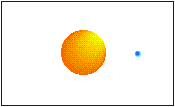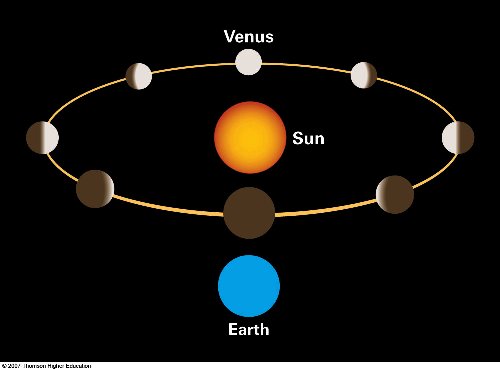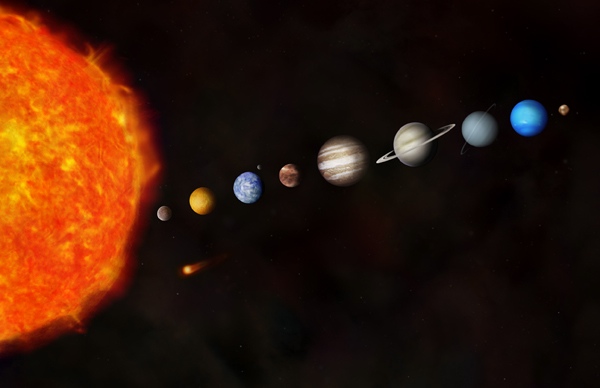 Discovery
Discovery 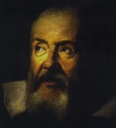
Navigating
1564 - 1642
From 1612-1613 evidence in the heavens sparked a debate. "Although Galileo was aware of the potentially explosive nature of this particular issue (the problem of the calendar and the shape of our solar system), he felt he could not stay silent, but decided to refute the argument." -- concerning small planets orbiting the sun, sun spots, and the Copernican theory.
Maurice A. Finocchiaro, The Essential Galileo.
zeitgeist | what is modern? | worldview | Influence | Copernicus | Background | Trial | Brecht | lesson
• A founder of modern science; astronomy, physics, mathematics.
• explained pendulums, falling bodies, law of inertia, projectile motion.
• confirmed the Copernican, heliocentric system in face of heresy.
• His trial became the scandal of Catholicism even as late as 1992.
"The events of of 1616 marked a turning point in Galileo's career. He was no longer free to research the earth's motion, since he was not supposed to hold or defend it but was to limit himself to discussing it hypothetically, or instrumentalistically."
Maurice Finocchiaro, The Essential Galileo. page 11.
The Copernican system:
"the daily revolution of the Earth on its axis, and with Aristarchus its yearly journey around the sun."
Dampier, p. 109.
"To Copernicus the primary question was what motions of the planetary bodies would give the simplest most harmonious geometry of the heavens. . . a simpler scheme than the Ptolemaic cycles and epicycles in which the heavenly bodies move around the Earth."
Dampier, p. 111.
A scientific problem of complex movement
The slow westward movement of the equinoctial points along the plane of the ecliptic by a rate of 50.27 seconds of arc per year resulting from a slow westward shift of the Earth's axis of rotation.
If the Sun is moving to the east, does that mean the moon moves to the west?
Overview:
Galileo: The person & the myth
High Middle ages and Renaissance 1300 - 1633 - 1660 is the English Revolution
Reformation of Christendom 1517 - Luther / Calvin, Zwingli
Counter-reformation 15631609-10, He perfects a telescope & publishes his observations.
1618-1648, The Thirty Years' War
1660 is the Restoration of James II, Britain
a sense of identity shifted, symbolism of the church underwent change, measuring reality with instruments created a new measures of the world.
"these are the days of miracle & wonder"
Middle Ages had created a strong hierarchical system that divided secular from sacred authority in which roles were determined by rank and service to the feudal order. Peasants were tied to the land, the Clergy possessed their own governing structure and the nobility was subject to oaths of fealty, entail, and obligations in an intricate order of fiefdoms ruled by Earls, Dukes, Princes, Kings as well as many other minor lords.
Medieval order was accompanied by a profound sense of place: personal, social, native, & cosmic order all emerged from this certainty of rank based on descent and pedigree.Into this system Universities were created by some Bishops for the purposes of a more learned and educated clergy and for the dissemination of works in Latin about the Greek and Roman heritage of law, letters, medicine, and mathematics.
This was the world into which Galileo was born, a social and political order changing ever so slowly but with a strong heritage of order and responsibility, despite the great Schisms in the Catholic Church that had split Orthodox from western Roman churches (1054) and the matter of dual Popes in Rome and Avignon (1378-1417). The Vatican remained opposed to the Copernican astronomy until 1922.
The entire controversy over the Copernican system's legitimate representation of the heavens rests on a question of how well mathematics and observation dispel uncertainties with regards to the apparent motion of planets, stars, sun spots and comets.
"In 1618 three comets appeared in succession, the third being especially bright and lasting" the sky and the commentary on these events by academics brought into question Aristotle's ancient assumptions that these objects were in the earth's atmosphere. As Galileo was drawn into the arguments his contention that these comets were not in the earth's atmosphere --based on their apparent motion-- held "an implicit defense of the banned Copernican system."
Maurice Finocchiaro, The Essential Galileo. pp. 12-13.
Holton's Three criteria for science:
- reason -- logical; deductive or inductive
- empiricism -- experimental evidence
- heuristics -- discoverable models
History of ideas vs. Biography
Primary vs. Secondary sources
The rationalization of humanism --
Science & Art
Foundations of Modernity:
Galileo - Descartes - Hobbes - Hooke - Newton - Locke
Newton referred to the world he created with the rationality of calculus, the certainty of gravity and the discoveries of telescopes as "modernity," because this new "mechanistic order" detectable by empirical means in the divine plan replaced earlier alchemical, algebraic and Aristotelian worlds.
Galileo's times:
zeitgeist.
Age of Discovery
from the Council of Trent, December 1545 until 1563
to the
English Revolution, 1640s; there ensued an ongoing challenge to authority.
Council of Trent, mostly Italian Bishops with the ascendancy of the Jesuit order.
The Council had been called to examine Catholic doctrine and the necessity of reform. Holy Roman Emperor Charles V had wanted abuses of the Papacy, the monasteries and the clergy looked at first in an attempt to please the Protestants and hopefully tempt them back to the church. Once Protestant churches were back, they could focus on redefining doctrine. Paul III did not want this approach of reconciliation as reforms could financially damage him and concessions could diminish Papal authority. The result was that two separate sections of the council dealt with reform and doctrine simultaneously. By 1563 the Papacy and fundamentalist Catholicism as distinct from either reconciliation among all Christians or heretical Protestantism had triumphed to become a cornerstone of Roman order until 1963.
The personality of and influences on Galileo;
Father was a music teacher, 1 of 7 children
Conflicts sacred & secular; thinkers versus doers
Writings:
Siderius Nuncius (1610) & Dialogo (1630)
Trial by the Roman Inquisition & faithful Christian Doctrine
Legacy of Galileo–Freedom of inquiry -- Kepler's Laws of Planetary Motion
Scientific Revolution–began to spread due to printing and instrumentation, but was characterized by three features:
- mechanism, belief in the "clock work" like behavior of the divine order
- utility, explanations were best that explained more things with the fewest assumptions, such as laws of gravity, or atmospheric pressure.
- efficiency - as a value arose based on new precise measurement, and a more regulated system for accurate weights and measures demanded by markets and revenue collectors.
Eventful moments in the Scientific Revolution
(internal history)
1452 The birth of Leonardo da Vinci. (April 15)
1477 earliest reprinting of Ptolemy's Geography
1492 First voyage of Columbus
1503 Vespucci's Novus Mundi
1509 Erasmus, In Praise of Folly
1520 Magellan's circumnavigation of the globe
1513 landing in Florida of Ponce de Leon
1517 The Reformation Luther's "The Ninety-Five Theses on the Power and Efficacy of Indulgences"
1519 Leonardo da Vinci's death (May 2)
1543 Copernicus' On the Revolution of the Heavenly Spheres
1545-63 Council of Trent
1582 (Oct 4) the Julian Calendar was changed by Pope Gregory
1590 microscope
1608 telescope perfected in Holland
1609 Kepler's Astronomia Nova,
1609 Galileo begins telescopic investigations
1615 winter two Dominican friar's --priests-- file complaints against Galileo
1618 three comets appear in the sky. The Thirty Years' War in the Holy Roman Empire between Catholic and Protestant German states began, drawing in Austria, Denmark, Sweden, & France by the 1640s.
1620 New Amsterdam est.; Bacon's, Novum Organum
1634 Thomas Hobbes met Galileo Galilei
1649 Beheading of Charles I of Great Britain
1687 Isaac Newton's Principia Mathematica
Popes of the period
1. Clement VIII (1592-1605) -- #232
2. Leo XI (1605)
3. Paul V (1605-21)
4. Gregory XV (1621-23)
5. Urban VIII (1623-44) ------- #236
Natural Philosophy was set against a newly emerging descriptive astronomy and empirical methodology.
1500 - 1600
Aristotle "the Master of those who know" said Dante (8)
the most profound characteristic of nature is change (process)
Euclid's Elements, Book V theory of proportionality was the most
read book of the ancient world (Greco-Roman period of 1st century through
the medieval period of the 15th century).
|
1. |
techne | the Greek idiom for practical knowledge | experience |
|
2. |
episteme | the Greek idiom for scientific knowledge | reason |
Their sources & goals were very different; prediction of events vs.
fundamental causes of conditions in which events occurred.
During the 16-17-18 centuries -- Scientific Revolution -- the search for laws replaced the preoccupation with causes (11). Such was Galileo's law of falling bodies -- there is a sureness & a necessity in the displays of Nature
Universities were conservative resisted the new knowledge from the field of mechanics, craftsmen, military -- civil & hydraulic engineers (16)
Even the church had asked Copernicus to solve a problem raised by the failure of existing calendars to accurately predict Easter!
Galileo was a craftsman, a measurer, and an experimenter who unlike Bacon & Descartes offered no overall philosophy of science. Instead he wedded theory & practice to predict the logical consequences of his observations. (2-20)
Galileo's fundamental difference from his detractors
was
"an epistemological conviction about reliable knowledge." (37)
"Measurement belongs to science; eternal truth belongs to faith, whether philosophical or theological."
actual measurements of the speed (velocity = v) of free fall confronted Galileo with problems that natural philosophers had avoided. "rigorous quantitative analysis of continuous change"
"God speaks in the language of mathematics." Galileo is told to have said.
Galileo an introduction | More on Galileo | Science and Galileo
Galileo's
Early influences, family:
Mother's work & piety {faith, practicality, devotion}
His Father's music {meter, measurement, order}
Galileo's intellectual antecedents:
Euclid's Elements most widely read book of antiquity
Archimedes -- measurement & predictable laws of behavior
Aristarchus -- measurement & heliocentric cosmos
Copernicus -- corrected the error in measurement - heliocentric
Kepler (1598 saw his work) combined observation & math.1583, Galileo -- outside of the University first read Euclid's Elements
1586 he investigated hydrostatic balance based on Archimedes
great influence of a practical sort & mathematics in music from his father Vincenzio {mathematical law based on string length}1587 his notoriety led to a friendship with Christopher Clavius who taught astronomy in the Jesuit College in Rome
1589 Chair of Mathematics at University of Pisa (3 year appointed )
1592 University of Padua (VENICE) Professor of Mathematics, but tensions grow with Rome, expulsion of the Jesuits, & growth in the power of the Inquisition.1600 condemnation and burning of Giordano Bruno as a heretic.
Galileo an introduction | More on Galileo | Science and Galileo
1600 the burning of Giordano Bruno at the stake by the Inquisition in Rome.
Galileo's academic experiences:
pendulum experiment 1602
craftsmanship -- ocular scope, 1609 thermometer
experiment -- hydrostatics & motion, falling bodies' rates not due to mass
design for a harbor at Livorno
observation of the heavens: moon, Jupiter's moons, Saturn's rings, Venus' phases.
Fra Paolo Sarpi befriended Galileo - lifelong intellectual friendship Galileo wrote Sarpi initially about acceleration (1604) 1610 the telescope.
For Galileo, military necessity dictated many practical inquiries into surveying, fortifications, harbors, & mechanics!
1595 Galileo used Copernicus for the first time formally to describe his equations about the tides -- practical investigation
1602 pendulum experiment -- he became good at setting them up
1603 motions & velocity of falling balls on an inclined plane.
"distances from the rest are as the squares of the
elapsed times." (33) careful measurement -- frequent errors but a
willingness to correct those errors.
Galileo an introduction | More on Galileo | Science and Galileo
Three Movements collided during his lifetime:
Reformation
From 1517 on through 1648 the creation of Protestant opposition to the Roman church and related religious wars tore European civil society apart challenging sacred and secular order.Giordano Bruno burnt by the Inquisition in 1600 as a heretic.
Kepler a German Lutheran had proved Copernicus correct by 1610.Aristotelians and his authority in natural philosophy
division of ethereal and earthly matter; the heavens as sublime & in motion, versus the earth as base matter at rest.
Ptolemaic, geocentric universeAuthority of the high clergy
factions of the Church split: Jesuits versus Dominicans
Roman inquisition (est. 1542), the Index of prohibited books (est. 1571), & strict rules for heresy trials adopted in 1588.Dominicans were the purveyors of the Inquisition.
Galileo an introduction | More on Galileo | Science & Galileo | Essential Galileo
Galileo proposed that the Copernican model based on the heliocentric conception of the solar system was the correct way to interpret the behavior of planets, moons, comets, and the Earth's position third from the sun yet circled by its singular moon moving about the solar system.
Sidereus Nuncius, (1610) views of the Moon, sunspots, Jupiter's "Medicean Stars", the phases of Venus, experimental philosophy
"Again, it is a most beautiful and delightful sight to behold the body of the Moon . . ."
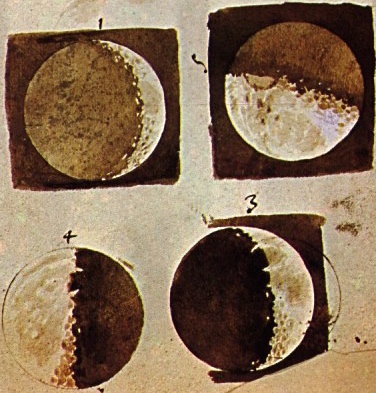
"I have discovered four planets, neither known nor observed by any one of the astronomers before my time, which have orbits round a certain bright star, one of those previously known, like Venus & Mercury round the Sun, and are sometimes in front of it, sometimes behind it, though they never depart from it beyond certain limits."
"Now let me review the observations made by me . . . inviting the attention of all who are eager for true philosophy. . . ."
"just as the shadows in the hollows of the Earth diminish in size as the Sun rises higher, so also the spots on the Moon lose their blackness as the illuminated part grows larger and larger."
"The grandeur of such prominences and depressions in the Moon seems to surpass both in magnitude and extent the ruggedness of the Earth's surface. . . ."
Galileo an introduction | More on Galileo | Science and Galileo
El Dialogo
"The First Day"
The character and effectiveness of those laws of nature
Philosophical foundations of the "new astronomy"
two theories as to the substance of heavenly bodies
invention of writing
9 Copernicus 10 Aristotle 11 Plato 12 Geometry
14 Aristotle's divisions of the universe "the Celestial & the
Elemental"
32 "Sensible experience must be preferred to human reason."
33 helio vs. geocentricity
56 telescope
72 proof of the moons rough surface
"The Second Day"
physical arguments are inconclusive on the diurnal motion of the earth
about its axis & around the sun
Peripatetics vs. Alexandrians {ancient centers of Greek science}
observation & telescope
inertia
laws of falling bodies
centrifugal force
pendulum
analytic geometry
112 - 120
to 151
"The Third Day"
letting the conclusion influence your view of the data and affecting
your presentation of adequate evidence
276 - 278
daily rotation and annual revolution of the earth
proof: due to moving sunspots
circle as perfect motion (Platonic & Ptolemaic)
stars as observable evidence for the earth's rotation
377-400
Tides in the Adriatic & Atlantic require the motion of the earth, 416-
Galileo an introduction | More on Galileo | Science and Galileo
Galileo's
Dialogue on Two Great World Systems
[1632]
"Several years ago there was published in Rome a salutary edict which, in order to obviate the dangerous tendencies of our present age, imposed a seasonable silence upon the Pythagorean opinion that the earth moves."
"its origin . . . in passion none too well informed."
"clip the wings of reflective intellects by means of rash prohibitions." {p-1}
"a witness of the sober truth."
"You speak very well; therefore there is no doubt that whoever wants the earth to move along the circumference of a circle must first prove that it is not at the center of this circle." Salvatio to Sagredo.
"That the world is finite, bounded, and spherical is proved by Aristotle with many demonstrations." Simplicius responded.
"I have taken the Copernican side in the discourse." {5}
"they are content to adore the shadows, philosophizing not with due circumspection but merely from having memorized a few ill-understood principles." {6}
Written to commemorate two Italian intellectuals:
Giovanni Francesco Sagredo Venetian
Filippo Salviati Florentine
"May it please those two great souls, ever venerable to my heart, to accept this public monument of my undying love."
Trial of Galileo April 12, 1633 -until- 22 June 1633.
Background
Files of his trial include information on Galileo from 1611
February and March of 1615 two Dominican priests complained to the Inquisition about Galileo's astronomical observations on the Earth's motion leading the Inquisitorial consultants to suggest the idea to be false and absurd as a matter of natural philosophy and heretical as a matter of faith.
February 1616 Galileo had been forbidden by Cardinal Bellarmine and the Inquisition to publish any defense of the Earth's movement in space.
1616 Holy Inquisition had banned the profession of belief in Copernicus as heretical
1632 Pope Urban VIII wrote: "Your Galileo has ventured to meddle
with things that he ought not to and with the most important and dangerous
subjects which can be stirred up these days,"
Trial presided over by Ten judges; all Cardinals of the
Dominican Order
neither charges nor evidence was shared with the accused
written documents need not be produced
"I abjure, curse & detest the aforesaid errors and heresies,
and generally every other error & sect whatsoever contrary to the
said Holy Church,"
G. Galilei, 22 June 1633
Galileo an introduction | More on Galileo | Science and Galileo
El Dialogo
THREE PRINCIPLE HEADINGS:
1) experiments on earth are insufficient to conclusively prove the earth's motion or rest.
2) celestial phenomena will be examined, strengthening the Copernican hypothesis.
3) propose an ingenious speculation about the motion of the tides and the earth's diurnal rotation.
"Brecht was all wrong about the seventeenth century in general and about Galileo Galilei in particular."
It is a paradox. The historical truth, rejected for its implausibility, has the air of an artifact, whereas the actual artifact, the play, has an air of truth."
Another paradox: only when a figure has become legendary is he or she a good subject for a history play."
Because the historical dramatist is concerned with the bits of history that have stuck in people's imagination, he may well find himself handling bits of pseudo-history that are the very products of people's imagination."
"After all, very much of our 'knowledge' of the past is based on fiction."
"So should we be prepared to see a modern, Marxist playwright distorting history in order to prepare young Communists for some future Battle of Russia?
. . . even for spectators who know that a history play is bad history, such a play might still seem to have some sort of special relevancy, a more urgent truth."
The present often intrudes upon the past:
The Church's canonization of Joan of Arc (1920s) after World War One!
"Like Saint Joan (GB Shaw) and all other good history plays, Galileo
is about the playwrights own time.
"There are two Galileo plays here, both exist in their entirety, the version of 1938, and the version of 1947."
"He [Brecht] was a poet, but a poet in love with the idea of science, a poet who believed that his own philosophy was scientific:"
Brecht's words:
1930s
"Take care when you travel through Germany with the truth under your
coat!"
1940s "The atomic age made its debut at Hiroshima in the middle of
our work. Overnight the biography of the founder of the new system of
physics read differently."
"In this respect, Galileo I is a 'liberal' defense of freedom against tyranny, while Galileo II is a Marxist defense of a social conception of science against the 'liberal' view that truth is an end in itself." {18-19}
Is Galileo or "the people" the real hero? {33-34}
"Galileo, according to Brecht, was one who at a crucial moment was
disloyal to his 'side' in the 'the fight.' That can hardly be unimportant.
The character will stand, as Brecht intended, as an exemplar of a certain
kind of weakness. But will it not stand, even more impressively, as the
exemplar of human greatness, a proof that greatness is possible to humankind?
For that matter would the weakness be even interesting if it were not
that of a great (which is to say: in many ways, a strong) man?" {41-42}
"The Science Fiction of Bertolt Brecht" by Eric Bentley, Drama critic
Brecht's attributions to Galileo the legend -- universal qualities:
1 truth or many truths
power or pluralism
ethics or moral certainly
special circumstances:
vernacular (Italian) challenge to authority [Latin]
anomalies in the heavens; comets, Medicean moons, Venus
wars of the Reformation (1517-1648)
empirical evidence for heliocentricity, precession of the equinox
Galileo's significance:
Assault on Aristotelian doctrines
NeoPlatonism & new mathematics
Conservation of motion
Copernican
observational & experimental method
mathematical proof
practical crafts people
useful science
inventive viewpoint
modern worldview
mechanism
atomism
mercantilism
According to Gerald Holton an historian at Harvard any description in order to be scientific must be refutable and be consistent across three different perspectives or have integrity:
1. THEORETICAL or rational -- see Gell-Mann and Einstein
2. EMPIRICAL or experience -- see Newton and Darwin
3. HEURISTIC or discoverable -- see Feynman and Watson
Ancient cosmology stressed: Cosmos was alive; made up of Four elements (earth, air, fire, water) ; earth was the center of the heavens and made of base matter; celestial realm was dwelling place of perfect forms, this world was a reflection of the celestial quintessence; humans were part of a "SCALA NATURA" (a chain of being) and were divinely made (as were all things) of four material humors and an immortal soul. Two oppositional forces called gravity and levity account for the movement of the heavens and the disc-like earth.
A refutable theory
Copernican vs. Ptolemaic world
systems
Superior relation of theory to empirical observation:
Eclipses - earliest recorded eclipse is 19 March 721 BC
- 29.5 days = 1 lunation of moon about the earth
- 19 year cycle = 235 lunations
On the Julian calendar by 1425 the vernal equinox fell earlier and earlier than March 21
by 1570, the equinox was falling 10 days before 21 March. The October 1582 calendar was calculated on the basis of the Copernican model of the cosmos.
Hipparchus in 127 BC recognized that the equinoxes move with respect to the fixed stars and this is called a:
"precession of the equinoxes"
Modern conceptions of the universe suggest that inanimate matter --in the form of 92 natural elements make up the cosmos; that humans like all life have evolved using 26 of those elements. Four basic forces account for the movement of quarks, atoms, molecules, and galaxies in a hierarchy of material forms with the sun as a small star in an arm of the Milky Way galaxy of stars.
Comments on the scientific method.
The Thirty Years' War:
The incendiary quality of the counter-Reformation sparked this prolonged strife to begin in 1618, when the Archbishop of Prague ordered a Protestant church destroyed. The Protestants rose up in revolt, but within two years the rebellion was stamped out by the Austrian Habsburg general, Count of Tilly.
